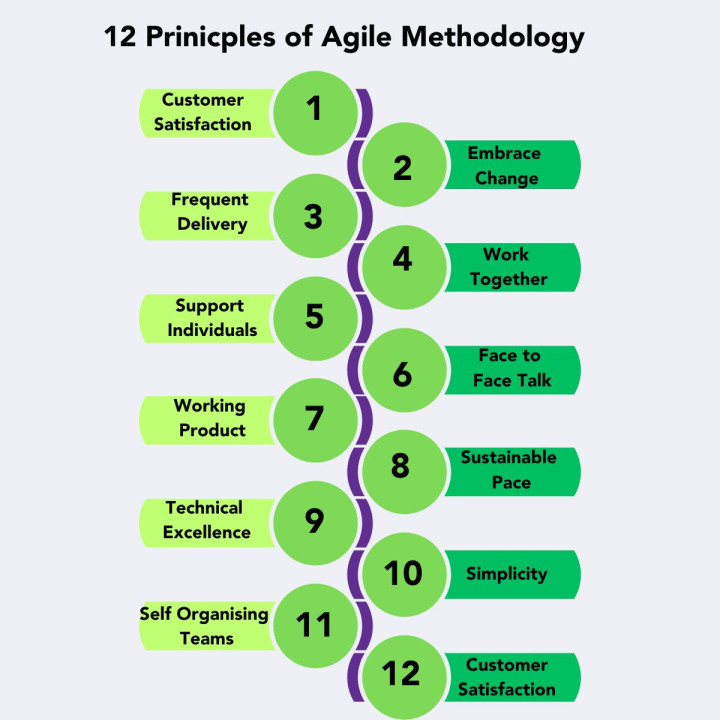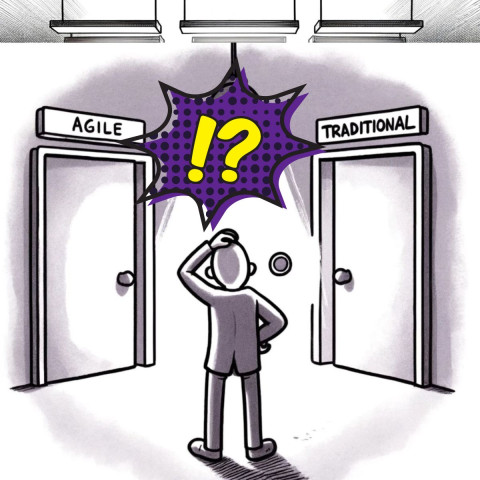What is the Agile Development Model?
HOW AGILE ARE YOU AND YOUR BUSINESS?
What is the Agile methodology?
The Agile methodology is a flexible approach to project management that emphasises repetitious development, collaboration, and customer feedback.
Unlike traditional Waterfall* methods, Agile promotes adaptive planning, allowing teams to respond to changes and deliver incremental improvements throughout the Agile development process.
The many Agile frameworks provide specific methodologies for implementing these principles, enabling teams to deliver high-quality products efficiently and effectively.
Agile project management isn’t just useful for software project management—all types of teams have been successful with this dynamic methodology.
*The Waterfall method is a traditional project management approach used primarily in software development. It is characterized by a linear and sequential design process that flows downwards (like a waterfall) through several phases.
What is the Agile Manifesto?
The Agile Manifesto is a document that focuses on 4 values and 12 principles for Agile software development.
It was published in February 2001 by 17 software developers who needed an alternative to the more linear product development process. The manifesto represented a departure from heavy documentation and rigid processes in favour of customer collaboration, responsive change, and working software.
What are the 4 values of Agile?
As outlined in the Agile Manifesto, there are four main values of Agile project management:
- Individuals over processes and tools
- Agile teams value team collaboration and teamwork over working independently and doing things "by the book.”
- Working software over comprehensive documentation
- The software that Agile teams develop should work. Additional work, like documentation, is not as important as developing good software.
- Customer collaboration over contract negotiation
- Customers are extremely important within the Agile methodology. Agile teams allow customers to guide where the software should go. Therefore, customer collaboration is more important than the finer details of contract negotiation.
- Responding to change over following a plan
- One of the major benefits of Agile project management is that it allows teams to be flexible. This framework allows for teams to quickly shift strategies and workflows without derailing an entire project.

What are the 12 Agile principles?
If the 4 values of Agile are the weight-bearing pillars of a house, then these 12 principles are the rooms you can build within that house. These principles can be easily adapted to fit the needs of your team.
They expand on the four core values outlined in the Agile Manifesto to provide a more detailed set of principles for conducting Agile projects.
1. Our highest priority is to satisfy the customer through early and continuous delivery of valuable software.
This principle emphasises the importance of delivering valuable and functional software to customers early and updating it frequently based on their feedback.
2. Welcome changing requirements, even late in development. The Agile development process harnesses change for the customer's competitive advantage.
Agile methodologies are designed to accommodate changes to requirements at any stage of the development process, enabling clients to compete more effectively.
3. Deliver working software frequently, from a couple of weeks to a couple of months, with a preference to the shorter timescale.
Regular, frequent delivery of functional software is central to Agile, providing immediate value to customers and allowing for rapid adjustment based on their feedback.
4. Business people and developers must work together daily throughout the project.
This principle underlines the importance of continuous collaboration between the project team and stakeholders to ensure that the final product meets business needs.
5. Build projects around motivated individuals. Give them the environment and support they need, and trust them to get the job done.
Agile emphasises the significance of empowering team members, providing them with the necessary resources and trust to complete their work effectively.
6. The most efficient and effective method of conveying information to and within a development team is face-to-face conversation.
Direct, face-to-face communication is considered the best way to convey information, fostering clear understanding and minimising misunderstandings.
7. Working software is the primary measure of progress.
In Agile, progress is measured by the delivery of functional software, rather than traditional metrics like completed documentation or hours worked.
8. The Agile development model promotes sustainable development. The sponsors, developers, and users should be able to maintain a constant pace indefinitely.
Sustainability in work practices ensures that teams can maintain productivity and well-being over the long term without burnout.
9. Continuous attention to technical excellence and good design enhances agility.
Emphasising technical excellence and good design improves agility by making the software easier to update and extend in the future.
10. Simplicity—the art of maximising the amount of work not done—is essential.
Focusing on simplicity helps to reduce waste, minimise rework, and increase efficiency by concentrating only on work that adds value.
11. The best architectures, requirements, and designs emerge from self-organising teams.
Agile supports the idea that teams that organise themselves are more effective in solving complex problems and delivering high-quality solutions.
12. At regular intervals, the team reflects on how to become more effective, then tunes and adjusts its behaviour accordingly.
Regular retrospectives allow teams to reflect on their performance and make continuous improvements to their processes and interactions.
These principles guide the Agile software development, ensuring a flexible, collaborative, and customer-focused process.

Real-World Applications of Agile
Agile methodologies have found applications across a variety of industries beyond just software development, where they originated. Here are some real-world applications of Agile
- Software Development
- This is the most direct application of Agile methodologies. Companies use Agile to adapt to changing customer needs, deliver products faster, and enhance team collaboration.
- Marketing
- Agile marketing teams use iterative approaches to adjust their campaigns quickly based on feedback and changing market conditions. This helps them be more responsive and relevant in their strategies.
- Agile marketing teams use iterative approaches to adjust their campaigns quickly based on feedback and changing market conditions. This helps them be more responsive and relevant in their strategies.
- Product Development
- Beyond software, Agile principles are used in developing physical products. It allows companies to rapidly prototype, test, and iterate on product designs, responding effectively to consumer feedback.
- Healthcare
- Agile methodologies are being applied in healthcare projects to improve patient care and manage complex healthcare systems. It helps in the rapid development of healthcare software and improves collaboration across different stakeholders.
- Education
- Schools and educational institutions are applying Agile to curriculum development and classroom management, allowing for more adaptive learning experiences and better student engagement.
- Schools and educational institutions are applying Agile to curriculum development and classroom management, allowing for more adaptive learning experiences and better student engagement.
- Manufacturing
- Agile can help streamline manufacturing processes, enhance product quality, and reduce time-to-market. It enables teams to adjust quickly to changes in production requirements or market demands.
- Agile can help streamline manufacturing processes, enhance product quality, and reduce time-to-market. It enables teams to adjust quickly to changes in production requirements or market demands.
- Construction and Engineering
- Although traditionally very structured, these industries are starting to adopt Agile methods for project management to better handle changes and reduce delays in construction projects.
- Although traditionally very structured, these industries are starting to adopt Agile methods for project management to better handle changes and reduce delays in construction projects.
- Human Resources
- HR departments are using Agile to improve processes like recruiting, onboarding, and employee development. This approach helps them to be more responsive and cater to the needs of the employees and the organization more effectively.
- HR departments are using Agile to improve processes like recruiting, onboarding, and employee development. This approach helps them to be more responsive and cater to the needs of the employees and the organization more effectively.
- Government Projects
- Even in the public sector, where processes can be rigid, Agile methodologies are being employed to improve efficiency, reduce waste, and deliver better services to the public.
- Even in the public sector, where processes can be rigid, Agile methodologies are being employed to improve efficiency, reduce waste, and deliver better services to the public.
In all these fields, the core Agile principles of collaboration, customer feedback, and iterative development are applied to bring about better outcomes, adapt to changes quickly, and improve overall efficiency.
Challenges and Considerations
While Agile offers numerous benefits, there are challenges to its implementation, including resistance to change, lack of understanding and commitment, and difficulties in scaling.
Organisations must consider their specific context, culture, and goals when adopting Agile.
It is essential to provide adequate training, maintain open communication, and foster a culture of collaboration and continuous improvement.
Read our article on 'The Pros and Cons of Agile methodology'
https://bespokeuk.com/posts/th...
What does the future hold for Agile?
Agile software development has revolutionised the way organisations approach software development and project management. By embracing the principles of flexibility, customer collaboration, and continuous improvement, Agile enables teams to deliver better products faster and more efficiently.
As technology and market conditions continue to evolve, the importance of Agile methodologies is likely to grow, making it a crucial skill set for developers and project managers worldwide.
Refer to our article on 'What does the future hold for iterative Agile?'
https://bespokeuk.com/posts/wh...
While there are numerous Agile methodologies, the choice of which to implement can vary based on the specific needs of the project, the team’s size, and the organisational environment. Despite their differences, all share the common Agile principles of collaboration, flexibility, continuous improvement, and a focus on delivering high-value products to customers.
Agile methodology offers a dynamic framework that can lead to enhanced product quality, higher customer satisfaction, and more engaged teams. However, the transition to Agile requires a comprehensive understanding of its principles, a commitment to continuous improvement, and the flexibility to adapt practices to fit the organisation's unique context. As the business environment continues to evolve, the ability to navigate the pros and cons of Agile will be critical for organisations aiming to remain competitive and responsive to customer needs.

Mailchimp Alternatives Guide 2025
Is Mailchimp still the best FOR EMAIL MARKETING? Or are UK businesses find...
5 min read

The Hidden Cost of Poor System Integration
Why Poor Integration Between Systems Is Holding Your Business Back And How...
8 min read

Admin Overload: The Silent Business Killer
The cost of manual, repetitive admin tasks In countless small and medium-s...
3 min read


